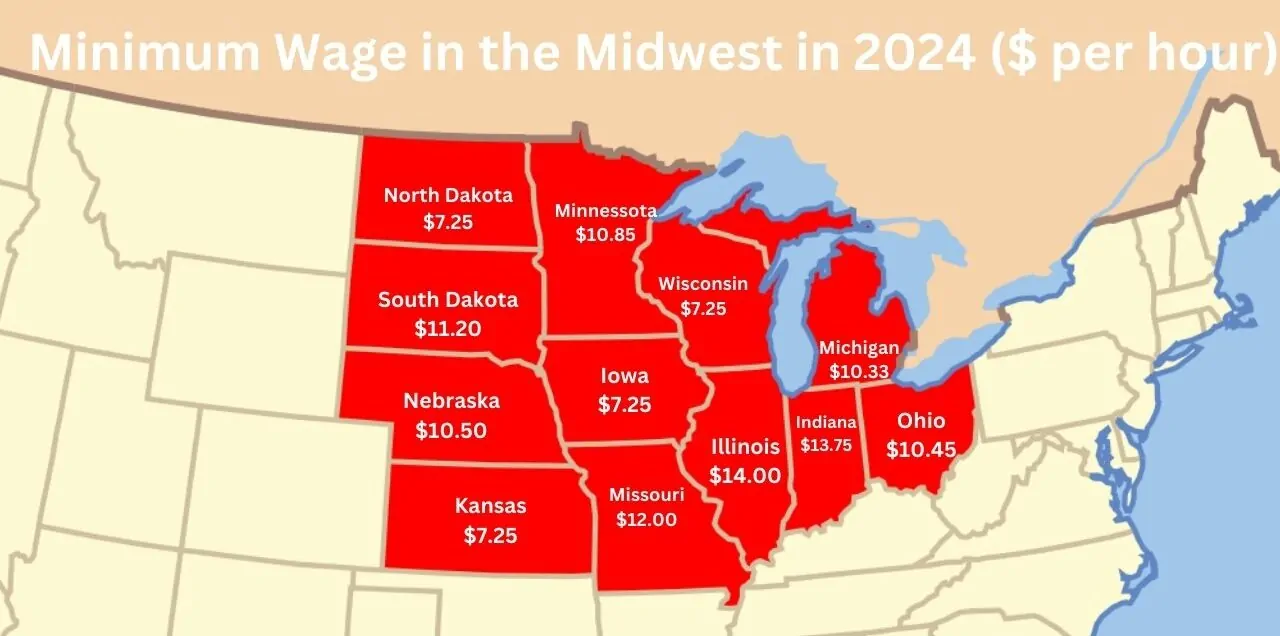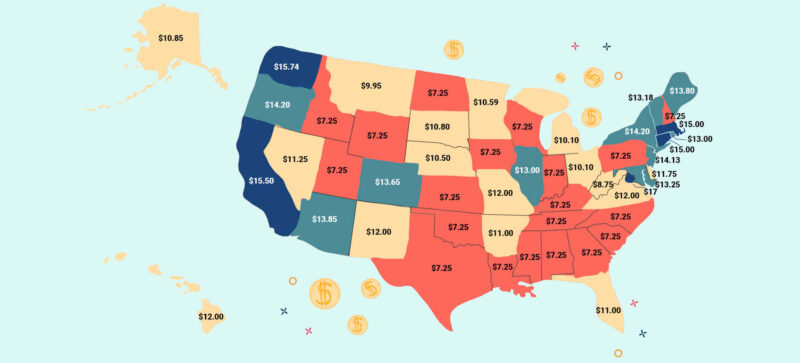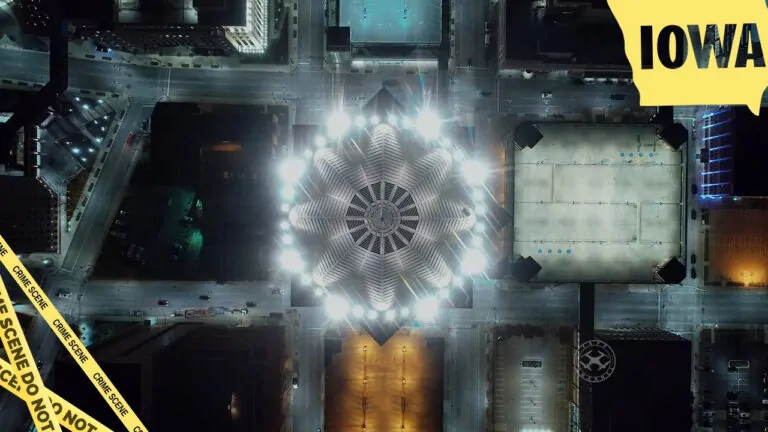Minimum Wage in Iowa remains a significant issue in 2024. The rate stands at $7.25 per hour, unchanged since 2008. It mirrors the federal standard, which has not increased since 2009.
While neighboring states have moved forward with higher rates, Iowa has not followed suit, leading to ongoing discussions about the economic effects and the well-being of workers.
The challenges tied to Iowa minimum wage highlight the need for examining why progress has stalled and what it means for those facing rising expenses.
Table of Contents
ToggleComparison With Federal Minimum Wage

The current rate has been unchanged since January 2008, mirroring the federal minimum wage, which also stands at $7.25.
Iowa is among 20 states that have not increased their minimum wage beyond the federal level.
- Key Insight: The last time Iowa adjusted its minimum wage was in 2008, raising it from $6.20 to $7.25.
- Federal Stagnation: The federal rate has remained the same since July 2009.
Economic Impact on Workers
Stagnant wages in Iowa affect a significant portion of the workforce. A higher minimum wage would benefit thousands of workers, especially those in low-income sectors like retail, healthcare, and food services.
Demographics Affected
- Women and people of color are overrepresented among minimum-wage earners.
- Nearly 26.2 percent of Iowa’s workforce would see a direct or indirect impact from a wage increase.
Cost of Living and Wage Gaps
Iowa’s cost of living continues to rise. According to Common Good Iowa, 1 in 6 full-time workers in Iowa earns an income that does not meet a basic needs budget, despite working full-time. Over half of single-parent families in Iowa do not earn enough to cover a bare-bones budget, facing an annual deficit of over $20,000.
The data also shows that one-third of working Black and Latino families have incomes insufficient to cover basic needs. Institutional racism and historic economic inequities, like redlining, have played a role in these ongoing disparities.
Monthly Income vs. Basic Expenses in Iowa
| Category | Monthly Cost | Annual Cost |
|---|---|---|
| Housing | $1,200 | $14,400 |
| Food | $750 | $9,000 |
| Child Care | $900 | $10,800 |
| Healthcare | $700 | $8,400 |
| Transportation | $500 | $6,000 |
| Miscellaneous | $400 | $4,800 |
| Total | $4,450 | $53,400 |
Reality Check: A full-time worker earning $7.25 per hour makes just $15,080 annually, well below what is needed to meet basic living expenses.
Comparisons with the Neighboring States

While Iowa has kept its minimum wage at $7.25 per hour since 2008, several surrounding states have implemented higher rates, making Iowa one of the least competitive states for low-income workers.
| State | 2024 Minimum Wage | Notes on Adjustments |
|---|---|---|
| Iowa | $7.25 | No adjustments since 2008 |
| Illinois | $14.00 | Will increase to $15 by 2025 |
| Minnesota | $10.85 | Adjusted annually based on inflation |
| Nebraska | $10.50 | Set to reach $15 by 2026 |
| Missouri | $12.00 | Adjusted yearly for cost of living |
| South Dakota | $11.20 | Adjusted annually based on inflation |
Minimum Wage Comparison in the Midwest (2024)
Impact on Workers and the Economy
The stagnant Iowa minimum wage significantly affects workers and the broader state economy. With the rate remaining at $7.25 per hour since 2008, many families face challenges meeting basic living expenses. The economic impact extends beyond individuals, influencing entire communities.
Who Is Affected the Most?
Certain demographic groups in Iowa are disproportionately impacted by the low minimum wage. These include:
- Women: Women represent a large share of minimum wage earners in Iowa, often working in service and caregiving roles.
- People of Color: Workers of color are overrepresented in low-wage jobs.
- Full-Time Employees: Many minimum wage workers are employed full-time but still struggle to make ends meet.
- Parents: Families with children face added financial pressure, as the cost of essentials like childcare and healthcare continues to rise.
Economic Ripple Effect
The low minimum wage in Iowa creates a ripple effect throughout the economy. Workers earning $7.25 per hour have limited purchasing power, which reduces consumer spending and slows economic growth.
- Lower Consumer Spending: A low minimum wage means less disposable income, impacting local businesses.
- Increased Reliance on Assistance Programs: Many low-wage workers rely on government assistance to cover basic needs, putting additional strain on state resources.
| Income Type | Annual Amount | Living Wage Standard |
|---|---|---|
| Minimum Wage Income | $15,080 (full-time) | $33,000 (single adult) |
| Income Gap | $17,920 (shortfall) |
Estimated Annual Income at $7.25 vs. Living Wage in Iowa
Long-Term Consequences
- Health and Well-Being: Chronic financial stress is linked to poor health.
- Educational Barriers: Economic instability can lead to lower educational achievement for children in low-wage households.
Federal vs. State Wage Policies
The federal minimum wage stands at $7.25 per hour, unchanged since 2009. This rate applies to employers covered under the Fair Labor Standards Act (FLSA), which includes most businesses. While many states have raised their minimum wage above this level, Iowa remains one of the states that have not implemented any changes.
- Federal Legislation: The Fair Labor Standards Act established the minimum wage in 1938, initially setting it at 25 cents per hour. Over the years, there have been several increases, but none since 2009.
- Inaction at the Federal Level: Efforts to increase the federal minimum wage have faced political hurdles, with the last significant push occurring in 2023 through the Raise the Wage Act.
How State Wage Policies Differ?
States have the flexibility to set higher minimum wages. As of 2024, 30 states and the District of Columbia have rates above the federal minimum. In contrast, Iowa has not adopted any higher wage standards, despite growing economic pressure.
| State | Minimum Wage | Adjustment Policy |
|---|---|---|
| California | $16.00 | Indexed to inflation |
| New York | $15.00 – $16.00 | Regional adjustments |
| Illinois | $14.00 | Incremental increase to $15 by 2025 |
| Colorado | $14.42 | Adjusted annually |
| Oregon | $15.45 (Portland area) | Regional adjustments |
States with Minimum Wages Above $10 per Hour (2024)

The Case for State-Level Adjustments
Advocates argue that states should tailor minimum wage policies to reflect local economic conditions. For Iowa, this means addressing the cost of living, which has outpaced wage growth.
- Economic Variability: States with higher costs of living have adjusted their minimum wages to keep up, while Iowa has not.
- Local Authority Limits: In 2017, the Iowa legislature passed a law preventing cities and counties from setting their own minimum wages above the state level.
The Debate Continues
Supporters of raising Iowa minimum wage emphasize the need to address income inequality and improve living standards. Opponents, however, worry about potential impacts on small businesses and employment rates.
Legislative Efforts and Challenges
Over the last decade, several proposals have been introduced to increase the minimum wage in Iowa, but none have succeeded.
- 2016 Proposal: A bill aimed to raise the minimum wage to $10.10 per hour but failed to pass in the Republican-controlled legislature.
- 2017 Local Ordinance Repeal: Several counties, including Johnson and Polk, had set higher local minimum wages. The Iowa Legislature overturned these ordinances, mandating a uniform state rate of $7.25.
- Ongoing Proposals: Democratic lawmakers have continued to introduce bills to raise wages, yet none have advanced in the legislature.
Political Roadblocks
One of the biggest hurdles in increasing Iowa minimum wage has been the political landscape. The state government, dominated by conservative leadership, has often prioritized business concerns over wage increases.
- Business Opposition: Groups representing businesses argue that higher wages could lead to job losses and increased operating costs.
- Partisan Divide: Democrats have generally supported wage hikes, while Republicans have resisted, citing economic risks.
Economic Concerns and Counterarguments
Opponents often argue that raising the minimum wage could hurt small businesses and lead to higher unemployment. However, studies from the Economic Policy Institute and other research organizations challenge this view.
- No Clear Evidence of Job Loss: Research indicates that moderate wage increases do not necessarily result in significant job losses. Instead, higher wages can boost consumer spending and stimulate economic growth.
- Cost Savings from Lower Turnover: Higher wages often reduce employee turnover, saving businesses money on recruitment and training.
Key Arguments For and Against Raising Iowa Minimum Wage
| Arguments For | Arguments Against |
|---|---|
| Improves living standards for low-income workers | Potential job losses in low-wage sectors |
| Boosts consumer spending and economic growth | Increased operating costs for small businesses |
| Reduces reliance on government assistance | Risk of higher prices for goods and services |
| Supports wage equity, especially for women | Concerns about economic competitiveness |
Proposals for Wage Increases
Efforts to increase the minimum wage in Iowa have come from various lawmakers and advocacy groups. Some of the most notable proposals include:
- 2014 Proposal: Democratic lawmakers introduced a plan to raise the minimum wage to $10.10 per hour. The bill gained attention but failed to advance in the Republican-majority legislature.
- 2019 Push for $15: Advocacy groups and some state legislators pushed for a $15 minimum wage. This proposal aimed to phase in increases over several years but faced strong opposition.
- Raise the Wage Act of 2023: This federal proposal seeks to raise the minimum wage to $17 by 2028. If passed, Iowa workers would see significant benefits, but the act has yet to gain sufficient traction.
Estimated Impact of Raising Iowa Minimum Wage to $15

| Impact Area | Projected Effect | Source |
|---|---|---|
| Consumer Spending | Increase by $300 million annually | Economic Policy Institute |
| Poverty Reduction | Lift 140,000 Iowans above poverty | Common Good Iowa |
| Business Turnover Reduction | Lower turnover costs by 10-15% | National Employment Law Project |
| Employment Concerns | Minimal impact on overall employment | Bureau of Labor Statistics Analysis |
Public Support and Grassroots Movements
Public opinion polls indicate that a majority of Iowans support increasing the minimum wage. Grassroots movements, led by organizations like the Fight for $15, continue to advocate for change, emphasizing the human impact of wage stagnation.
FAQs
Why does Iowa still have one of the lowest minimum wages in the country?
Iowa’s minimum wage remains at $7.25 because state lawmakers have not passed any legislation to increase it. The state government has historically prioritized business interests, and efforts to raise the wage have faced strong political resistance.
Are there any proposed laws that could raise Iowa minimum wage soon?
Currently, there are no active state-level proposals expected to succeed. However, the Raise the Wage Act at the federal level could bring changes if passed. Advocates continue to push for increases, but the likelihood depends on political shifts.
How does Iowa’s minimum wage compare to inflation and cost of living?
The $7.25 rate does not keep up with inflation or the rising cost of living. Over the past 15 years, the purchasing power of the minimum wage has decreased, making it harder for workers to afford necessities like housing, healthcare, and food.
Can cities or counties in Iowa set their own minimum wage?
No, Iowa state law prevents cities or counties from setting higher local minimum wages. In 2017, the state legislature overturned local ordinances that had raised wages, mandating a uniform statewide rate of $7.25.
Last Words
Iowa minimum wage remains a critical issue that impacts thousands of workers and the broader economy. Despite ongoing debates and legislative proposals, progress has been slow. As costs of living continue to rise, the question remains whether state leaders will prioritize meaningful wage reforms or maintain the status quo.
For now, Iowa’s workers, advocates, and policymakers remain engaged in a complex struggle, one that will shape the economic future of the state.














